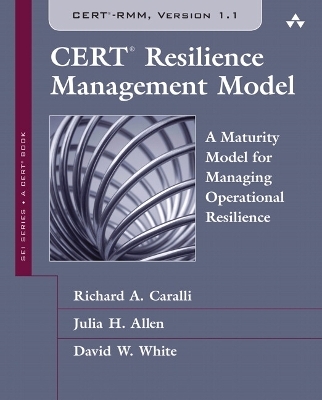
CERT Resilience Management Model (CERT-RMM)
Addison Wesley (Verlag)
978-0-13-454506-6 (ISBN)
- Titel z.Zt. nicht lieferbar
- Versandkostenfrei
- Auch auf Rechnung
- Artikel merken
This book both introduces CERT-RMM and presents the model in its entirety. It begins with essential background for all professionals, whether they have previously used process improvement models or not. Next, it explains CERT-RMM’s Generic Goals and Practices and discusses various approaches for using the model. Short essays by a number of contributors illustrate how CERT-RMM can be applied for different purposes or can be used to improve an existing program. Finally, the book provides a complete baseline understanding of all 26 process areas included in CERT-RMM.
Part One summarizes the value of a process improvement approach to managing resilience, explains CERT-RMM’s conventions and core principles, describes the model architecturally, and shows how it supports relationships tightly linked to your objectives.
Part Two focuses on using CERT-RMM to establish a foundation for sustaining operational resilience management processes in complex environments where risks rapidly emerge and change.
Part Three details all 26 CERT-RMM process areas, from asset definition through vulnerability resolution. For each, complete descriptions of goals and practices are presented, with realistic examples.
Part Four contains appendices, including Targeted Improvement Roadmaps, a glossary, and other reference materials.
This book will be valuable to anyone seeking to improve the mission assurance of high-value services, including leaders of large enterprise or organizational units, security or business continuity specialists, managers of large IT operations, and those using methodologies such as ISO 27000, COBIT, ITIL, or CMMI.
The authors are senior technical staff members within the CERT Program of the Software Engineering Institute (SEI). Richard A. Caralli, Resilient Enterprise Management technical manager, develops and delivers methods, tools, and techniques for enterprise security and resilience management. He has led the development of CERT-RMM. Julia H. Allen conducts research in operational resilience, software security and assurance, and measurement and analysis. She served as the SEI’s Acting Director and Deputy Director/COO and authored The CERT® Guide to System and Network Security Practices (Addison-Wesley, 2001). David W. White, a core member of the CERT-RMM development team, develops CERT-RMM and related products and helps organizations apply them.
List of Figures xi
List of Tables xiii
Preface xv
Acknowledgments xxi
Part One: About the Cert Resilience Management Model 1
Chapter 1: Introduction 7
1.1 The Influence of Process Improvement and Capability Maturity Models 8
1.2 The Evolution of CERT-RMM 10
1.3 CERT-RMM and CMMI Models 15
1.4 Why CERT-RMM Is Not a Capability Maturity Model 18
Chapter 2: Understanding Key Concepts in CERT-RMM 21
2.1 Foundational Concepts 21
2.2 Elements of Operational Resilience Management 27
2.3 Adapting CERT-RMM Terminology and Concepts 39
Chapter 3: Model Components 41
3.1 The Process Areas and Their Categories 41
3.2 Process Area Component Categories 42
3.3 Process Area Component Descriptions 44
3.4 Numbering Scheme 47
3.5 Typographical and Structural Conventions 49
Chapter 4: Model Relationships 53
4.1 The Model View 54
4.2 Objective Views for Assets 59
Part Two: Process Institutionalization and Improvement 65
Chapter 5: Institutionalizing Operational Resilience Management Processes 67
5.1 Overview 67
5.2 Understanding Capability Levels 68
5.3 Connecting Capability Levels to Process Institutionalization 69
5.4 CERT-RMM Generic Goals and Practices 73
5.5 Applying Generic Practices 74
5.6 Process Areas That Support Generic Practices 74
Chapter 6: Using CERT-RMM 77
6.1 Examples of CERT-RMM Uses 78
6.2 Focusing CERT-RMM on Model-Based Process Improvement 80
6.3 Setting and Communicating Objectives Using CERT-RMM 83
6.4 Diagnosing Based on CERT-RMM 92
6.5 Planning CERT-RMM—Based Improvements 95
Chapter 7: CERT-RMM Perspectives 99
Using CERT-RMM in the Utility Sector, by Darren Highfill and James Stevens 99
Addressing Resilience as a Key Aspect of Software Assurance Throughout the Software Life Cycle, by Julia Allen and Michele Moss 104
Raising the Bar on Business Resilience, by Nader Mehravari, PhD 110
Measuring Operational Resilience Using CERT-RMM, by Julia Allen and Noopur Davis 115
Part Three: CERT-RMM Process Areas 119
Asset Definition and Management 121
Access Management 149
Communications 175
Compliance 209
Controls Management 241
Environmental Control 271
Enterprise Focus 307
External Dependencies Management 341
Financial Resource Management 381
Human Resource Management 411
Identity Management 447
Incident Management and Control 473
Knowledge and Information Management 513
Measurement and Analysis 551
Monitoring 577
Organizational Process Definition 607
Organizational Process Focus 629
Organizational Training and Awareness 653
People Management 685
Risk Management 717
Resilience Requirements Development 747
Resilience Requirements Management 771
Resilient Technical Solution Engineering 793
Service Continuity 831
Technology Management 869
Vulnerability Analysis and Resolution 915
Part Four: The Appendices 943
Appendix A: Generic Goals and Practices 945
Appendix B: Targeted Improvement Roadmaps 957
Appendix C: Glossary of Terms 965
Appendix D: Acronyms and Initialisms 989
Appendix E: References 993
Book Contributors 997
Index 1001
| Erscheinungsdatum | 25.02.2016 |
|---|---|
| Verlagsort | Boston |
| Sprache | englisch |
| Maße | 10 x 10 mm |
| Gewicht | 1501 g |
| Themenwelt | Informatik ► Netzwerke ► Sicherheit / Firewall |
| Mathematik / Informatik ► Mathematik ► Finanz- / Wirtschaftsmathematik | |
| Wirtschaft ► Betriebswirtschaft / Management | |
| ISBN-10 | 0-13-454506-0 / 0134545060 |
| ISBN-13 | 978-0-13-454506-6 / 9780134545066 |
| Zustand | Neuware |
| Haben Sie eine Frage zum Produkt? |
aus dem Bereich


